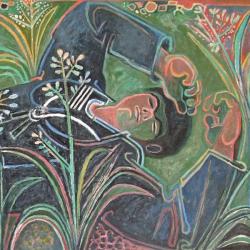Invitation to attend a writing workshop in response to the work of John Craxton led by Redell Olsen (Judith E. Wilson Poetry Fellow).
The workshop will begin with a short tour of the John Craxton Exhibition by David Scrase (assistant director and curator). Students will then be encouraged to respond to the exhibition through writing and discussion towards the production of their own poems and art writing.
Places are limited so if you would like to attend please email Dr. Redell Olsen rso10@cam.ac.uk by 10 am Monday January 20th.
Also a reminder that the Judith E. Wilson Contemporary Writing Group resumes on Monday 20th January and runs from 1 – pm in the Judith E. Wilson Drama Studio http://www.english.cam.ac.uk/writing-studio/
See Notes of Courses for further details.
Part 2
Handout from Workshop:
“Ekphrasis is the verbal representation of graphic representation” James Heffernan.
How useful is this definition for writing poems in response to paintings?
(Difficulties of aboutness) and Generating a first response…
Make a note of any facts, questions or points of interest that are sparked by the introduction to the work given by the curator and by your initial encounter with the exhibition.
Choose a painting that interests you and write for 5 – 10 minutes in response to the painting in whatever way interests you.
Writing about paintings….
Consider how you would describe the painting to someone who had not seen it. What are its key elements (2-5 mins).
Write as a factual a description as you can which considers its material elements: use of line, drawn and painted elements, colour, textures, tone, brush strokes, painterly techniques, frame etc. (2-5 mins).
Consider the subject matter. In very basic terms what is this a painting of? Is this the same as what it is about? (2-5mins). Do the paintings provoke any questions perhaps with regard to representation, the biography of the artist, narrative….? Or anything else?
Paintings About
Consider some of the following as possible starting points for writing about the painting(s): place, site, landscape, memory, dream, vision, animals, narrative (write for 5 – 10 minutes while actively considering any or some of these themes).
Isolate some of the key areas of interest that you have identified in your chosen painting and see how these themes or subject matters relate to other paintings in the room (5 – 10 mins). For example how do the different presentations of places, goats, cats and sailors etc. relate across paintings? What narratives, questions, ideas connect the representations?
About Writing Through Paintings
How do you feel about the wider contexts of this exhibition? How does your own body in relation to the site shape your seeing of the paintings? How do other people look at paintings? Can you reflect on how you are seeing the paintings? / your surroundings?
Many of Craxton’s poems feature poets, dreamers or artists in a landscape. What is your response to these representations of the poet / artist? How do these representations relate to you the writer of your poem here and now?
Now return to your original painting – or choose another if you prefer – and write more freely by allowing the painting to suggest associations related to your own experience and ideas from elsewhere. You might consider how the images relate to your own experience and memories or perhaps they remind you of other works by artists that you might know? (5 -10 mins.)
About Art Technique = Poetic Technique
How does Craxton’s use of paint suggest a related form in writing? Choose some of the painterly techniques that you find in the paintings and consider how they relate to an equivalent stylistic use in words. Apply this to your existing writing or revisit one of the paintings with this in mind.
Experiment with writing slowly, quickly, in short lines, long lines….
Choose one of the poems about painting to consider. What do you notice as interesting about the way that the poet has chosen to write about the painting or the work of art?
Poems Discussed:
All the poems here respond to paintings in various ways:
‘Roses’ Barbara Guest
‘The Round World’ Rosemarie Waldrop
‘Cezanne’s Ports’ Allen Ginsberg
‘Our Nature’ Rae Armantrout
‘The Hunter In the Snow’ William Carlos Williams
‘The Hunt by Night’ Derek Mahon
How might it be useful to consider the techniques or form of the poem that you have chosen in relation to the development of your own writing of a poem about / in response to Craxton’s paintings?
Return to the writing that you have produced and underline phrases, ideas, words or sections that seem particularly worth keeping / developing.
Consider the form of the poem that you chose in relation to the writerly / painterly technique that you developed earlier. How might you develop each of these?
Try to coalesce your notes, writing and ideas into a short poem that you can discuss in relation to your experience of the exhibition and also in relation to the poem that you chose.
Consider repetition and the visual form of the poem on the page…
Prepare to contribute to the group with a reflection on your process and ideas and / or a reading of your poem.
